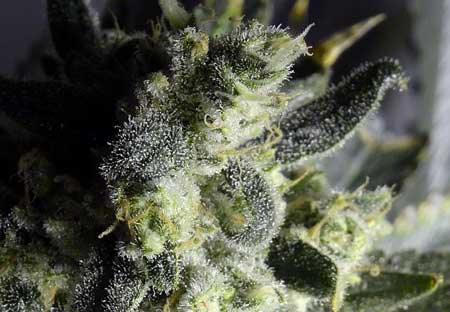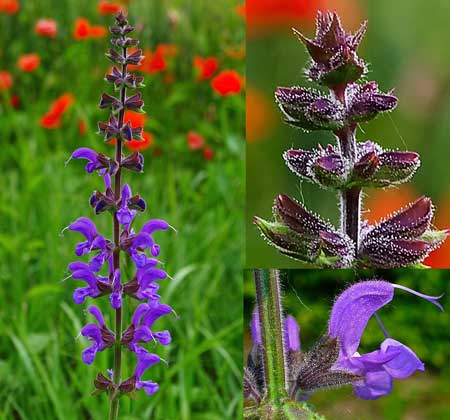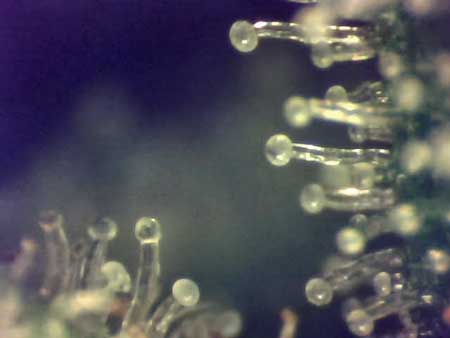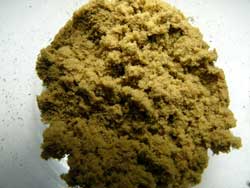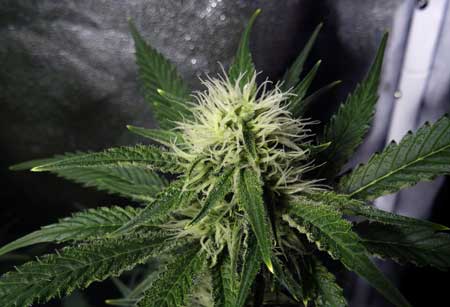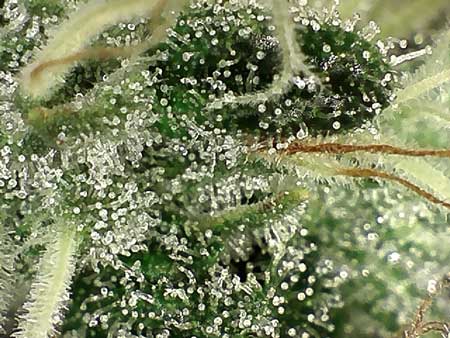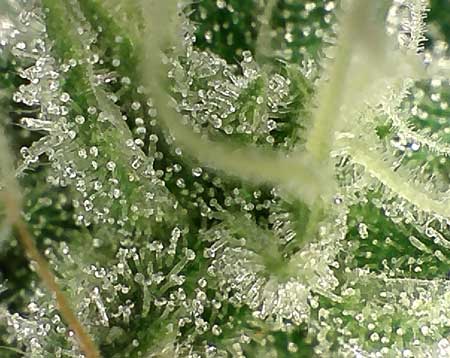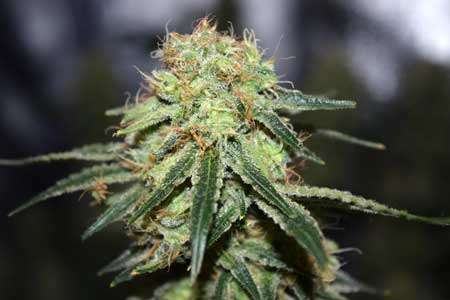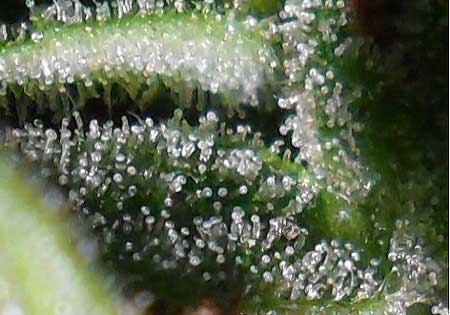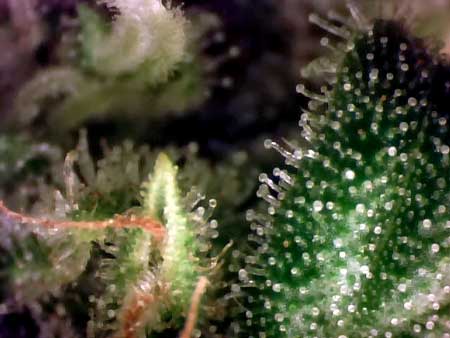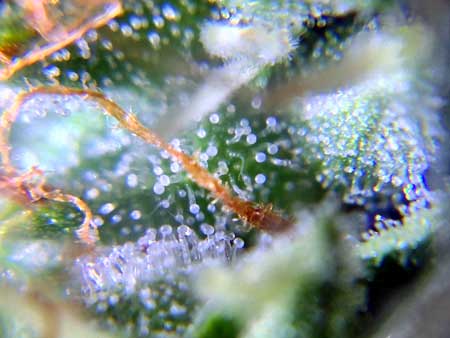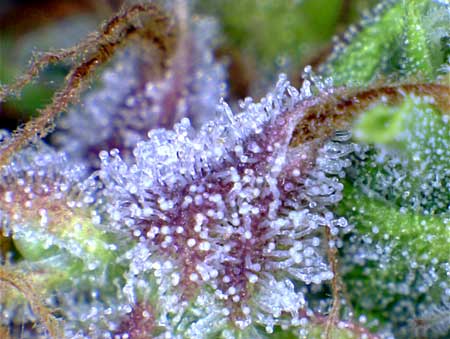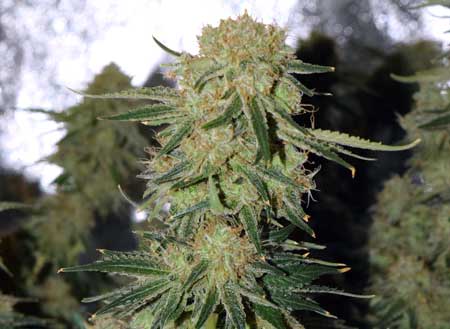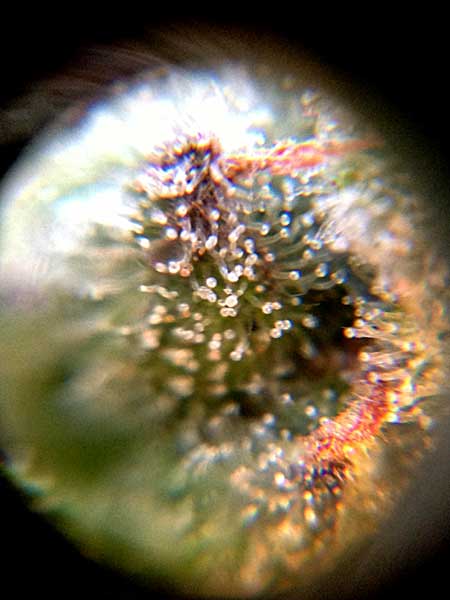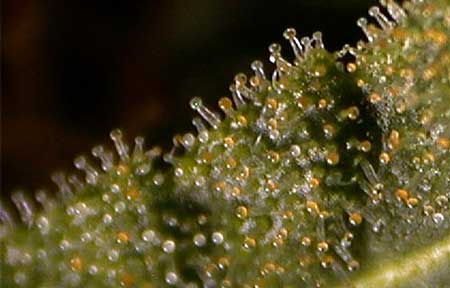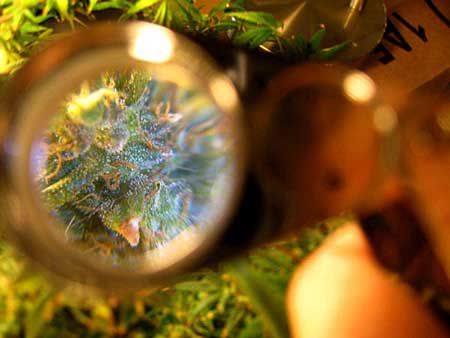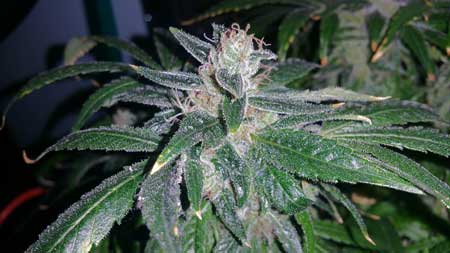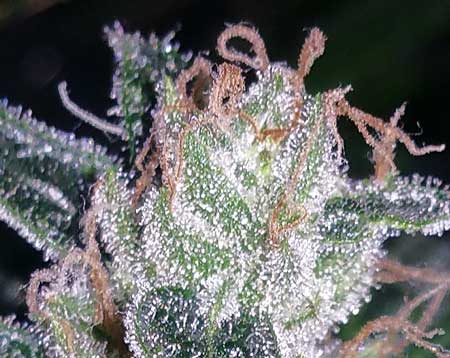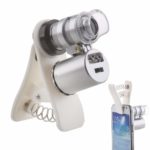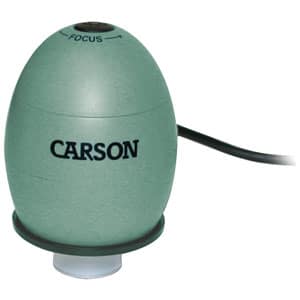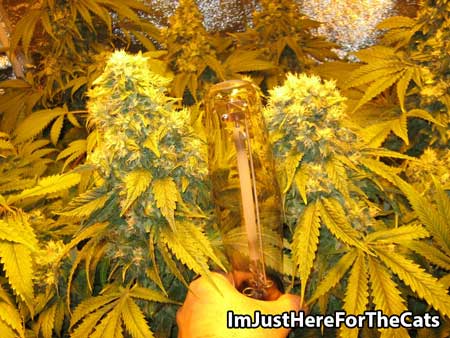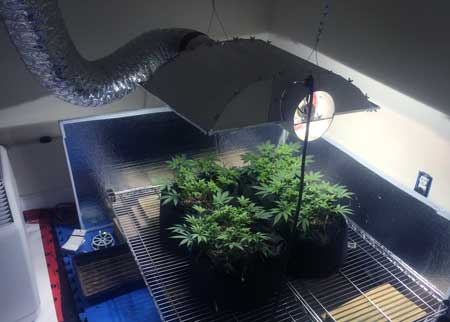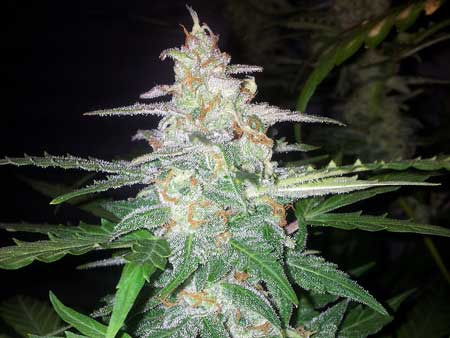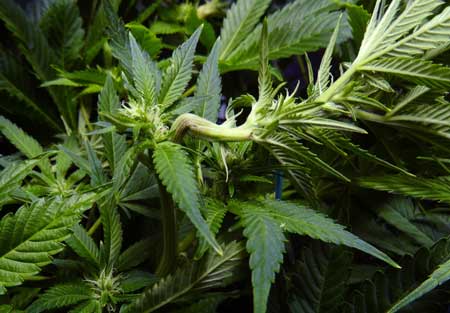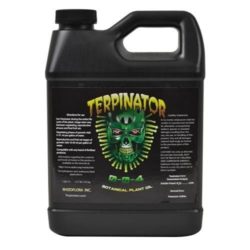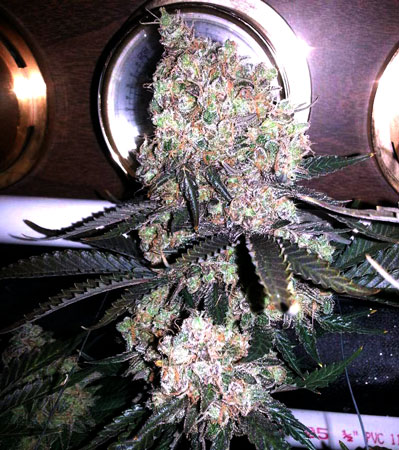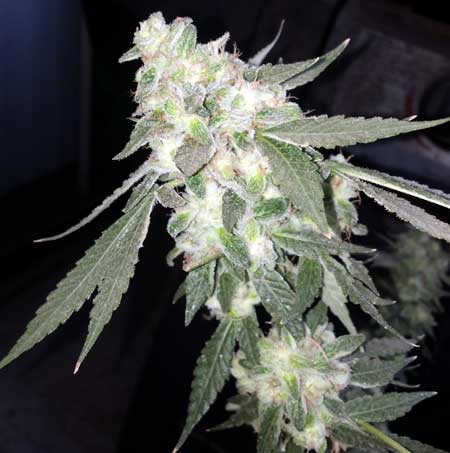by Nebula Haze
Table of Contents
When to Harvest Weed For the Highest Potency
- 4 Stages of Trichome Development (Harvest Stage 2 or 3)
- How to Easily See Trichomes Up Close
How to Increase Number of Trichomes on Cannabis Buds
What Are Trichomes on Cannabis Plants?
When cannabis growers say they want to make cannabis buds “sparkle” with trichomes, what are they talking about? The answer is: that ‘frosty’ quality that makes bud look like it might be too potent. As cannabis plants mature in the flowering stage, their buds become covered with what looks almost like a dusting of glitter or frost, which can improve their overall appearance.
When you look really closely at cannabis buds, you can see what looks like thousands of tiny translucent mushrooms. In nature, these glandular stalked trichomes are believed to be used by the plant to repel insects, protect the buds from UV damage and produce essential oils that have various effects.
The “glitter” that grows on marijuana buds is called trichomes and they contain THC and other cannabinoids. They give cannabis its unique mental and body effects.
Trichomes that are long and thin without a “head” are actually cystolithic hairs and do not contain significant levels of cannabinoids.
Many other types of plants besides cannabis produce trichomes, including many aromatic herbs like mint and rosemary. These plants produce essential oils in their trichomes which are used to deter insects and protect the plants from other stressors, just like cannabis plants!
Several different types of flowers, as well as many aromatic herbs like mint and rosemary, use trichomes to produce essential oils that attract/repel certain bugs and otherwise protect the plant. In this picture, the flowers and leaves of meadow sage (salvia) are covered in trichomes.
As a cannabis grower, you can actually look at the trichomes on your buds and get a good idea of when they have reached peak potency. The color and shape of the trichomes allow you to harvest your cannabis at the exact right time to achieve the effects you’re looking for.
With marijuana plants, the trichomes tell you when to harvest!
The color and shape of trichomes on cannabis buds give you information about when to harvest because harvesting at different times actually changes the effects and potency of buds.
In order to achieve the effects you’re looking for, it will serve you well to understand what trichomes look like at different stages of cannabis bud development, so you can harvest buds at the best possible moment!
About Using Pure Cannabis Trichomes…
Unlike cannabis buds, pure trichomes don’t need to “cure” before they can be smoked. Curing mainly affects the green plant matter in buds, and has much less of an effect on trichomes. So hash that collects on scissors/fingers (or kief collected via a screen) can be used right away even if the plant was just harvested.
However, cured plant matter actually contributes to the effects of buds. That means the effects from pure trichomes will be different from regular cannabis buds. Although different, most growers agree they’re both good 🙂
Kief or hash (basically words for pure trichomes) can be smoked right away because trichomes don’t contain green matter. This kief was collected from extra cannabis leaves after harvest using the dry ice hash method (click for a close-up!)
Learn the 4 Stages of Trichome Development
(When To Harvest Cannabis)
- Not Ready to Harvest – Trichomes are clear and thin. At this point buds have very little potency.
- Beginning of Harvest Window (Focus on Mental Effects) – Mushroom “heads” start to get fat and trichomes start to turn milky white. As more trichomes turn white, the levels of THC and psychoactive effects tend to increase, giving a more “soaring” effect.
- End of Harvest Window (Focus on Body Effects) – After most of the trichomes have turned white they will start turning amber/yellow which is a sign that the THC is starting to convert to different cannabinoids. As trichomes turn amber the mental effects of buds are slightly reduced, but buds get more of a “couchlock” effect, with lots of body relaxation.
- Buds Have Passed Peak (Makes You Sleepy) – After most of the trichomes have turned amber, the trichomes will start to wither and die. Buds harvested at this point tend to have smaller mental effects, and tend to make you feel sleepy.
All the trichomes are clear and thin before the buds are ready to harvest. If you harvest at this point it can cause “speedy” effects or give you a headache. Chances are your buds won’t be as potent as they could have been because THC levels will be lower. Additionally, your yields will definitely be much lower because cannabis buds put on a lot of bulk during the last 2-3 weeks.
At this point the pistils/hairs on the buds are still mostly white and sticking out
The trichomes are still almost completely clear, which means they are still not very potent
The “heads” of the trichomes are still small, another sign the plant is not ready to harvest
As the trichome heads fill with “good stuff” they will start looking more fat and heavy and will eventually fall over.
2.) Beginning of Harvest Window
Some of the clear trichomes are starting to turn milky white, and the “heads” of the mushrooms are getting fatter as the trichomes fill with cannabinoids and other good stuff.
At the beginning of the harvest window, at least 40-50% of the pistils on the buds have darkened and curled inwards.
If you look up close, about half the trichomes have turned cloudy white. At the very beginning of the harvest window, the buds haven’t reached peak potency yet, but the overall yields and potency will continue to improve all through Stage 2.
When most of the trichomes have turned from clear to milky or cloudy white, it means the trichomes have reached peak levels of THC and will produce the greatest psychoactive effects.
Harvest when nearly all trichomes are white for the greatest mental effects
Sometimes the trichomes of certain plants will never turn amber (for example some Sativa and Haze strains). As long as most of the trichomes have turned from clear and thin to fat and white you know it’s a good time to harvest even if you don’t see any amber.
As white trichomes start to turn amber/yellow, it’s a sign that the mental and psychoactive effects of THC will be lessened, but buds tend to produce more of a body-high or “relaxation” effect.
By the end of the harvest window nearly all the pistils will have darkened and curled in
When the trichomes are mostly cloudy with some amber, you’ll achieve a good mix of mental and body effects
The end of the harvest window is around when 20-30% of the trichomes have turned amber. This bud is getting close to the end of the harvest window, but at this point, it will still produce excellent mental and body effects!
If trichomes keep turning amber without being harvested, the buds begin to start losing potency. Buds that are harvested with more than 20% amber trichomes may make you feel sleepy.
Here’s a quick primer on how to get a good look at the trichomes on your buds.
- Jeweler’s loupe or small magnifier
- Take a picture and zoom in
- Camera phone attachment
- Digital microscope
1.) Jeweler’s loupe or small magnifier
Although these do make trichomes appear bigger, the main problem with loupes/magnifiers is that they don’t magnify things quite big enough for some people. At least with my eyes, I have trouble seeing trichomes well enough to determine the color under a loupe. That being said, lots of growers use these without a problem!
Also, you can’t beat the price 🙂 This loupe on Amazon costs less than $10!
If you take a clear picture of your buds with a phone or camera and zoom in, you can often see the trichomes clear enough to identify their color.
Tips for taking good pictures of trichomes
- Hold the phone or camera steady. It’s best if you can actually rest it on something so it doesn’t move at all. Even a little motion will make trichomes much less clear in pictures.
- Take the picture in bright natural light. Don’t take pictures under unnatural colored lights like LED or HPS grow lights because it makes it really difficult to see the trichome color. Dim light will also make trichomes almost impossible to see.
- Try Using the Flash – Try taking pictures with and without a flash, as it can make a big difference depending on the environment
- Take a few different pictures from different angles, and from both close and far. Sometimes if you put a camera or phone in too close everything gets blurry, so you may have to move the camera further back than you’d originally think in order to get a clear shot
- Optical Zoom – If your camera has an optical zoom (the lens can actually move as it focuses, like with most cameras but not phones) it can help to zoom in before taking the pic. Keep in mind that digital zoom (like what phones have) doesn’t help much.
Example, this picture was taken by a Samsung Galaxy 4 camera phone (2013 version) with the flash on. Many newer phones take even better pics!
If you zoom in really close, you can actually get a much closer view of the trichomes
In this case, nearly all the trichomes are white and fat, which means this plant is in the harvest window. However, sometimes even with a camera, it can be difficult to really see the trichomes.
Learn more about taking great pictures of your plants
Some phones have products that let you attach a small lens to your phone in front of the camera to magnify the image and take closer pictures. You can make these yourself by taking the lens out of a laser pointer and DIY attaching it to your phone, but the professional ones often are easier to use, and they cost less than $15.
A digital microscope is probably the easiest way to see the trichomes. They zoom in very close and allow you to take a video so you can really look at the trichomes after the fact.
When you see really nice pictures or videos of trichomes, it’s often because the media was taken with a digital microscope. These go in much closer than most magnifiers or cameras.
Here’s an example of a digital microscope in action – these buds are ready to harvest.
We took the above videos using the Carson zOrb hooked up to a laptop. So far this seems to be the most accurate and dependable way to look at trichomes we’ve found
Get a Carson Orb on Amazon.com
How to Increase Number of Trichomes on Buds
Trichomes are what make buds potent, so most growers are interested in making sure their cannabis plants produce as many trichomes as possible.
Here are the main strategies growers use to increase the number of trichomes so buds look like they’re covered in “glitter.”
- The Right Kind of Light
- Alter the Environment Near Harvest (Advanced)
- Stress Plants in a “Good” Way
- Trichome-Increasing Supplements
- Choose Strain That Naturally Grows Lots of Trichomes
Light needs to be very bright in the flowering stage
Cannabis plants grown under weak light tend to grow fewer trichomes and produce far less bud. The most trichome-encrusted bud is usually produced under very strong and bright grow lights like HPS grow lights.
Very strong grow lights like HPS bulbs make cannabis produce more trichomes than if the buds were under weaker lights in the flowering stage
UV-B/Sun/Metal Halide exposure
Some growers (including some famous ones like Ed Rosenthal) believe that exposing cannabis buds to UV-B light for the last 2-3 weeks before harvest can increase trichome production and overall potency. Although not yet proven, this may be partly because trichomes are theorized to help protect the plant from UV-B rays.
UV-B is the name for a “color” of light in the lower blue/violet spectrum that humans can’t see. It is produced by the sun and causes damage to plants and humans.
In fact, nearly all organisms on earth have defenses to protect themselves from UV-B rays. Humans get sun-burned if exposed to too much UV-B and can even get cancer in extreme cases, so our skin protects us by becoming darker in response to sunlight. Instead of a tan, plants produce trichomes that can help protect against UV-B rays (though trichomes also have many other uses such as producing cannabinoids and terpenes/essential oils/smells).
Metal halide grow lights produce UV-B light just like the sun! Although MH lights are generally only used in the vegetative stage like for these plants below, it may be helpful to expose buds to UV-B light for the last 2 weeks before harvest to increase trichome production.
Learn more about how light spectrum affects your plants
The most common source of UV-B light for growers (besides the sun of course) are Metal Halide grow lights. UVB light is also produced by incandescent bulbs but they aren’t really bright enough to be used for this purpose.
Just remember that glass blocks UV-B rays, so if you’re using a metal halide bulb in an enclosed hood, it’s important to remove the glass (and find another way to cool the light) so UV-B rays actually reach your plant’s buds. Another option for UV-B light is reptile lamps, though not a lot of growers have those hanging around the house, and they’re not as powerful as a Metal Halide lamp 🙂
Possibly LED grow lights
Although most LED grow lights don’t produce any UV-B light, some growers believe the unique light spectrum of many LEDs actually stress plants in a way that causes it to produce more trichomes as a defense response. In the wild, trichomes can protect the buds from many dangers, including bugs. That may be why the plant produces more trichomes in response to certain types of stress.
Learn more about how the spectrum of light changes how cannabis plants grow
This trichome-encrusted bud was grown under LED grow lights (click for a close-up)
2.) Environment: Alter Temperature & Humidity Near Harvest (Advanced)
The main thing to remember when it comes to altering your grow environment for the last 2-3 weeks before harvest is this:
- Humidity below 30% – Drop the humidity of the grow space below 30% RH for last 2-3 weeks before harvest to increase trichome production
- Temperature between 70-80°F – Make sure your temperature stays under 80°F (26°C) to ensure potency is not being baked right off your buds.
There are a couple of ways to lower the humidity while maintaining the right temperature:
- Dehumidifier – brings humidity down while giving off heat and increasing temperature; the more powerful the better
- Air Conditioner – brings humidity down while cooling the air
In extreme cases, I’ve heard of growers using both an AC and a dehumidifier at the same time to maintain that perfect temperature while dropping the humidity very low.
3.) Stress Plants in a “Good” Way
Since cannabis plants can produce trichomes as a response to certain types of stress, some growers try to stress cannabis in a “good” way to trigger that natural reaction.
The only proven way to stress plants in a good way is to lower the humidity and control the environment/lighting as stated above, but there are other unproven techniques that may or may not work. Since they are so popular, I think it’s important to mention them at least.
Some techniques like supercropping (bending stems without breaking the skin) may increase trichome production when done correctly
Stressing your plants can have negative consequences, like bud discoloration, re-vegging or hermies so it’s important to watch your plants closely. However, it’s usually safe as long as you save any major stress for the last week or two before harvest (so you’re not accidentally damaging your plant when it still has a long time to go). It’s also a good idea to ever avoid stressing plants that are already unhealthy or damaged.
Some strategies to stress plants to increase trichome production:
- Supercropping – Bending/snapping plants in a way that stresses them without “breaking the skin” (if done right this can increase yields, too)
- Other Physical Stress – I’ve heard of growers cutting leaves and putting nails though stems the last day or two before harvest. The later option makes me sad 🙁
- Give 24-48 hours of darkness just before harvest – Be careful because if you don’t have a lot of green healthy leaves, this may discolor your buds.
- Water plants with ice water just before harvest – I’ve heard of some growers giving plants icy water just before harvest to try to shock their roots. Again, this is an unproven method…
It’s not proven that these methods increase trichome production (though supercropping can certainly increase yields) but they are common strategies without much downside if they don’t work. If anyone has done a side-by-side comparison for any of these techniques, let us know!
4.) Trichome-Increasing Supplements
Some supplements claim to actually increase either the number of trichomes on your buds, or the potency of your buds. Although there are lots of “snake oil” products out there in the supplement world, some supplements have proven themselves time and again.
Rhizoflora Terpinator is one of the most popular supplements to help increase trichome production and is used by both hobbyist and commercial growers to increase both the number of trichomes and terpene (smell) production. There are probably other great supplements that do this, too, but this particular one has been tried and tested by many real cannabis growers.
5.) Choose a Strain That Naturally Grows Lots of Trichomes
If your strain doesn’t have the genetics to produce a lot of trichomes, there’s not a whole lot you can do to change that. Although the tips in this article will help you maximize the genes your plant already has, it can’t make up for mediocre/poor genetics.
With that being said, there are some strains that don’t show much glitter even though they are very potent (for example some Sativas and Hazes, Sour Diesel) so if you think glitter is important you have to pick the right strain. Here are some strains known for their glitter:
Critical Hog by TH Seeds
Not only does this strain make beautiful, sparkly buds, it also gets exceptional yields. Check out a grow journal from one of our readers featuring Critical Hog.
Tahoe OG by Cali Connection
This strain is often featured on the top shelf of dispensaries (at least here in Southern California) because the buds are particularly potent and pretty. These buds are so covered in frost they look almost white!
At this point, you’ve been armed with all the information you need to grow your own encrusted, trichome covered buds!
Now learn how to improve…

